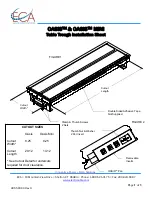
WCB11070 (PDF FORMAT)
12
©
Copyright Eaton Corp. 2007, All Rights reserved.
3.3.6.1
Static Pressure Test:
a) Release the tensioner by exhausting the air pressure
from the cylinder.
Ensure that the machinery will remain in a
safe position prior to releasing the brake.
b) Bleed all air from within the coolant cavity. Air bleeding
must be accomplished by running coolant through the
cavity with the tensioner secured in its proper operat-
ing position.
Note :
Avoid contaminating the friction material with
coolant or water.
Contamination of the friction material could
result in erratic or loss of torque.
c) After the air has been removed, install a pipe plug(s)
in the outlet(s) and apply maximum allowable coolant
pressure measured at the inlet to the water cavity.
Maximum allowable is 40 PSIG (2.7 bar) for size 36"
and 48" units, and 45 PSIG (3.0 bar) for all other
sizes. Maintain this pressure for 30 minutes. Check for
leakage at O.D. and I.D. sealing areas.
3.3.6.2
Dynamic Flow Test
:
a) Dynamic flow testing of the tensioner should be con-
ducted at the required flow rate for the rated HP dissi-
pation and coolant quality, as given in Table 6. Inlet
and outlet pressures for the appropriate tensioner size
as listed in Table 7 should not to be exceeded.
b) There should be no restrictions on the outlet side of
the brake to cause any back pressure to the unit.
Coolant inlet and outlet sizes are listed in Table 6. Full
size hoses and piping should be used. Check for low
flow and/or leakage at the O.D. and I.D. seal areas.
4.0
MAINTENANCE
Before performing any maintenance work on
the WCB2 tensioner, make sure that the
machinery will remain in a safe position. Fail-
ure to do so could result in serious injury or
possibly death.
Only qualified maintenance personnel should
install, adjust or repair the WCB2 units. Faulty
workmanship will result in unreasonable
exposure to hazardous conditions or per-
sonal injury.
Read these instructions thoroughly and
review until you fully understand the parts
replacement steps before proceeding with the
work described in this section. Failure to fol-
low these instructions can result in unreason-
able exposure to hazardous conditions or
personal injury.
4.1
Wear Limits
Periodically examine the tensioner for wear of
friction linings and wear plates. Failure to per-
form this examination periodically may result
in excessive wear to components, improper
operation or a significant reduction in torque,
and may result in personal injury and/or dam-
age to the machinery.
4.1.1
Wear limits for the WCB2 components are shown in
Table 13. If any wear limit has been reached or
exceeded, that component must be repaired or
replaced.
4.2
Wear Adjustment
If a wear adjustment is not made when
required, the brake torque may deteriorate to
the point where the equipment will not stop
properly.
4.2.1
Determining Wear
The friction material must be replaced when worn to
the bottom of the groove of the friction lining - as
shown on
Figure 6
(or O.D. "step" for size 48") - or
any "Y" or "Z" dimension exceeds the limits shown on
Table 10. On multi-disc units, a wear adjustment is
required when the "X" dimension has been reached
and the friction discs or "Y" or "Z" dimension(s) are
NOT worn to their limits.
















































